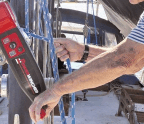
Soldering is the technique of joining two metals together by melting another metal onto their surfaces as a form of ‘adhesive’. Soldering doesn’t fuse the metals together as in welding.
For joining copper electrical wires, we use a solder of tin alloy, which has a relatively low melting temperature. This used to contain lead but mostly doesn’t nowadays.
The process of soldering causes oxidisation on the surfaces to be joined, and this prevents adhesion of the solder to the other metal surfaces. For this reason, a flux has to be applied to prevent oxidisation. For our purposes, the easiest way to do






